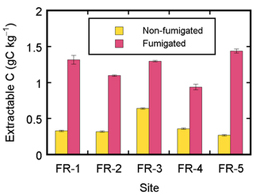Research Abstract
福島原子力発電所事故の影響を受けた森林表土における潜在的に移動しやすい放射性セシウムの保持
Retention of potentially mobile radiocesium in forest surface soils affected by the Fukushima nuclear accident
2012年12月19日 Scientific Reports 2 : 1005 doi: 10.1038/srep01005

福島原子力発電所事故の放射性降下物に由来する137Csの動態とこれに伴う放射線影響は、森林生態系の表土における137Csの移動性に大きく依存している。したがって、我々は森林表土(0~3 cm)における137Csの微生物による保持と物理化学的な吸着による保持を定量化した。K2SO4抽出によって、全137Csの2.1~12.8%が土壌から遊離した。粘土サイズとシルトサイズの粒子の含有量が多く、有機炭素を多く含み、陽イオン交換容量が大きい2種の土壌が、より高い137Cs抽出率を示した。微生物バイオマスは、すべての土壌に存在した。しかし、クロロホルムくん蒸によって微生物バイオマスを死滅させても、137Cs抽出率は増大せず、福島事故由来の放射性降下物の137Csの微生物保持を示す証拠は得られなかった。この結果は、非生物成分による非特異的なサイトにおけるイオン交換吸着と比べて、土壌微生物による137Csの取り込みは、潜在的に移動しやすい137Csの森林表土における保持にあまり重要でないことを示している。
小嵐 淳1, 守屋 耕一1, 2, 安藤 麻里子1, 松永 武1, 藤田 博喜3 & 永岡 美佳3
- 独立行政法人 日本原子力研究開発機構 原子力基礎工学研究部門
- 名古屋大学大学院 工学研究科
- 独立行政法人 日本原子力研究開発機構 東海研究開発センター 核燃料サイクル工学研究所
The fate of 137Cs derived from the Fukushima nuclear accident fallout and associated radiological hazards are largely dependent on its mobility in the surface soils of forest ecosystems. Thus, we quantified microbial and adsorptive retentions of 137Cs in forest surface (0–3 cm) soils. The K2SO4 extraction process liberated 2.1%–12.8% of the total 137Cs from the soils. Two soils with a higher content of clay- and silt-sized particles, organic carbon content, and cation exchange capacity showed higher 137Cs extractability. Microbial biomass was observed in all of the soils. However, the 137Cs extractability did not increase after destruction of the microbial biomass by chloroform fumigation, providing no evidence for microbial retention of the Fukushima-fallout 137Cs. The results indicate that uptake of 137Cs by soil microorganisms is less important for retention of potentially mobile 137Cs in the forest surface soils compared to ion-exchange adsorption on non-specific sites provided by abiotic components.

